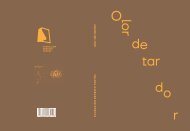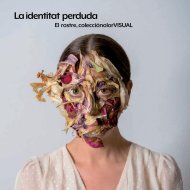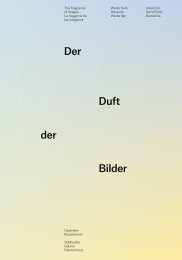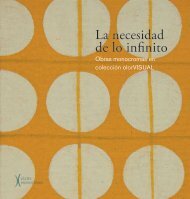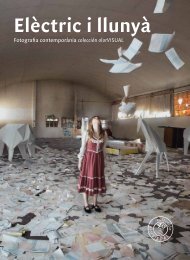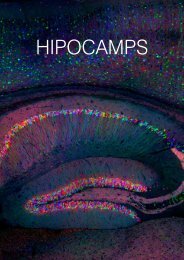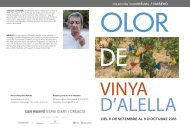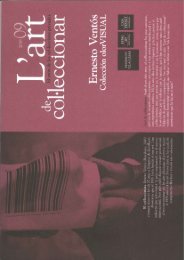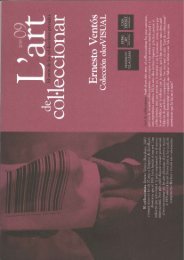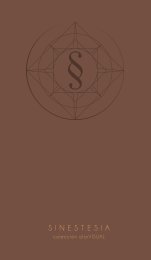Create successful ePaper yourself
Turn your PDF publications into a flip-book with our unique Google optimized e-Paper software.
stroke, we can immerse ourselves - if the<br />
artist is honest with his or her work - in the<br />
work's psychology in the same way that a<br />
mix of essential oils in a particular<br />
proportion gives every perfume its own<br />
character. Drawing is a speciallanguage of<br />
direct expression open to constant<br />
experimentation. lt is a highly flexible torm<br />
of w riting that gives the author a freedom<br />
of movement that is difficult to achieve in<br />
other artístic techniques. This is possible<br />
because hand and mind communicate<br />
directly through a f luid energy,<br />
automatically reflecting movements and<br />
emotions poured forth in lines traced upon<br />
paper.<br />
The artist's features are of great<br />
expressive value; they are a living entity<br />
which, with all their fullness or emptiness,<br />
concentration or expansion, movement or<br />
stillness, express aggression, sensitivity,<br />
sensuality, fear, etc. In short, they convey<br />
particular states of mind or view of the<br />
world, intangible, impalpable qualities that<br />
curiously are also to be fou nd in perfumes.<br />
However, we believe that the sense of<br />
smell is linked to a part of the brain that<br />
governs subconscious behaviour and<br />
that t he message o f s mel I touches us at a<br />
deep emotional level that visual and<br />
auditory information can never reach<br />
given that smell arouses primitive emotional<br />
responses.<br />
lt is this intimate interrelationship,<br />
therefore, between the worl ds of art and<br />
perfume - which would permit us to<br />
continue raising other parallels - which<br />
makes me dare on many occasions to<br />
interpret a work of art on the basis of<br />
criteri a used to appreciate perfume,<br />
differences of genre apart, of course.<br />
The essence of a collection<br />
Oriol Gual i Dalmau<br />
Collecting is an approach to life. There<br />
are those who collect stamps and others<br />
who collect coins or books or art. In short,<br />
there are people who collect everything<br />
including feelings, memories and<br />
nostalgia. The true collector is a<br />
compulsive being who lives in a strange<br />
world half way between pleasure and<br />
anxiety. Nothing is more pleasing to him<br />
or her than to acquire the desired object,<br />
than to get hold of that elusive piece, than<br />
to achieve some distant goal. However,<br />
these are ephemeral pleasures that barely<br />
last the time that it takes for a restless urge<br />
to rise up in the face of new objects of<br />
desire, new pieces, new apparently<br />
unattainable objectives.<br />
For the collector, each ítem gathered is<br />
an accumulation of sensations that go<br />
beyond the object itself or its beauty,<br />
unusual nature or aesthetic, documentary<br />
or financial value. lt is a cocktail of all<br />
these things, together with the memories<br />
associated with it, the difficulties<br />
overcome to possess it, and the anecdotes<br />
and experiences generated during the<br />
search for it. Evocation and memory are, in<br />
short, fundamentally important to the<br />
person who has carefully and passionately<br />
gathered together a collection. And this<br />
takes us back to perfumes.<br />
In the complex mechanism of the<br />
human brain , there are few things as<br />
capable of triggering memory as smells.<br />
An aroma, perfume or particular fragrance<br />
sudden ly emerges from all those<br />
enveloping us, though we pay them no<br />
heed, and our mind rushes back at<br />
dizzying speed to another place, anot her<br />
time, when this smell was closely linked to<br />
a moment of pleasure, grief, happiness or<br />
surprise. W ho does not have his or her<br />
private collection of smells? From the rich<br />
smell of the countryside after rain or the<br />
flurrying seent of jasmine on a summer's<br />
evening to the most private of perfumes<br />
such as, in my case, the smell of my first<br />
Jover or refried beans with bacon, which I<br />
will always associate with the house of my<br />
mother's parents and with the sound of<br />
Elena Francis on the radio.<br />
Despite all this, we are not accustomed<br />
to valuing our sense ot smell. For most<br />
species of animal it is a survival factor; for<br />
man it has become atavistic and has lost its<br />
importance in our everyday lives. Luckily,<br />
however, we humans are not all alike.<br />
For Ernesto Ventós, the sense of smell is<br />
primordial. Born into a family ot perfume<br />
makers and brought up surrounded by<br />
flasks of essential oils, he has dedicated his<br />
life to the subtle art of creating fragrances.<br />
A renowned expert in perfumes, he has<br />
invested and continues to invest many<br />
hours in educating his nose. Thanks to his<br />
determination and the time spent on his<br />
apprenticeship , Ernesto is capable of<br />
creating the most delicate of essences or<br />
the more prosaic smell of a burnt burger.<br />
Thanks to this skill, or perhaps driven by<br />
his compulsion, Ernesto is now an art<br />
collector.<br />
This perfumer has already shown his<br />
propensity for gathering unusual items in<br />
his remarkable collection of sticks with<br />
two uses. However, as he himself recounts<br />
in the introduction to this catalogue, it<br />
was his collaboration as a creator of<br />
perfumes in the exhibition 0/factory<br />
Suggestions that gave rise to his passion<br />
for contemporary art and eventually to<br />
this exhibition presented here. His<br />
unquenchable tenacity, his refined<br />
sensibility and his passion for the world ot<br />
smell, together with his urge to collect,<br />
mean that the inevitable was bound to<br />
occur: Ernesto has managed to gather a<br />
magnificent body of works of art in which<br />
the world of smells is the connecting bo nd.<br />
This is unquestionably an atypical<br />
collection in terms of both its contents and<br />
the way it was conceived. Ernesto Ventós<br />
is not the usual kind of collector. Most<br />
of the works gathered here were<br />
commissioned. Like the patrons of oid ,<br />
Ernesto asked the artists to produce a<br />
work related to the smell that they found<br />
the most evocative. Wor.king in this way,<br />
at a time w hen artists value their creative<br />
freedom above all else, has not always<br />
been responded to with understanding.<br />
However, this was not the end of the<br />
matter: to form part of the collection, each<br />
work must be supported by a text written<br />
or selected by the artist that reinforces the<br />
link between the painting or sculpture and<br />
the world of smell. Ernesto's forceful<br />
ability to convince, fed fundamentally by<br />
his enthusiasm and constancy, has fed to a<br />
collection of pieces by leading artists who<br />
have understood the nature of the project<br />
and have shared the dream of the person<br />
responsible for starting it up and seeing<br />
it through. The result is undeniably<br />
surprising.<br />
Behind each work of art lie long hours<br />
of almost entirely personal contact<br />
between the creator and collector, who<br />
enjoys inspiring the artist with enthusiasm<br />
for the idea. Hence, little by little, two<br />
collections in one have taken shape: one is<br />
a major collection of art and the other, no<br />
less important, is a group of friends.<br />
Visitors should let themselves be<br />
ensnared by the magic of the shapes, the<br />
sensuality of the textures and t he mystery<br />
of the lights and shadows, and they should<br />
make an effort to draw on their memory<br />
to evoke the s melis that each of the works<br />
in t he exhibition suggests. This is the only<br />
way to arrive at their true essence.<br />
Francesc Abad<br />
The shortness of saying<br />
the smell of the earth<br />
the smell of thinking<br />
We had the experience but missed the<br />
meaning,<br />
And approach to the meaning restores the<br />
experience<br />
T. S. Eliot, Four Quartets<br />
lt had not occurred to me to think<br />
about smell until Ernesto Ventós introduced<br />
me to doing precisely that. In fact, 1<br />
think that my work is implicitly related to<br />
smell, in the sense that nature, the landscape,<br />
the leaves, the tree-trunks ... have<br />
their own smell. I like the smell of the<br />
earth just after the rain, even the most<br />
everyday things like peeling potatoes, the<br />
earthy smell they have w hen they do not<br />
come from the supermarket. In fact, thinking<br />
has a smell; the smell of books, of<br />
their pages, is the smell of the letters, the<br />
interna! smell of reading and of thinking.<br />
Nature and thought, the externa! smell<br />
and the interna! smell, complement one<br />
another in their fragility, the smell of two<br />
worlds that exclude one another but are<br />
both witnesses to the ephemeral. Smell as<br />
the sense to which least attention has<br />
been paid, because smelling, perhaps, like<br />
thinking, does not have to be consciously<br />
carried out, but comes from silence, precisely<br />
because from them is where it is possible<br />
to create a work of art or an artístic<br />
work.<br />
Sergi Aguilar<br />
Smell of<br />
Desert<br />
S tones<br />
Tunnel<br />
Kanal Water Path<br />
Dry<br />
Sp i ces<br />
Riverbed<br />
Sa nd<br />
Earth<br />
Wet<br />
Frederic Amat<br />
Every perfume is the memory el an essence<br />
Another name in Perfumery to designate<br />
the essential oils extracted from aromatic<br />
plants. The use of the word essence<br />
may be a mistake, because at times it<br />
includes olfactive compositions giving the<br />
impression that these are the result of the<br />
extract of a natural product w hen in<br />
actual fact it is a reconstitution with no<br />
other relation to the plant than that of an<br />
olfactive similitude.<br />
Amat<br />
Peratallada, 12 .VI.93<br />
Miquel Barceló<br />
Still-life that reeks of life<br />
In relation to those artists w ho create<br />
the new world of art -the so-called<br />
impulse of the present- on the basis of<br />
odourless, artificial technologies and fantastical<br />
imaginaries, Barceló does so «in<br />
the sam e way». That is, according to the<br />
specific manner of the Catalan contribution<br />
to the unive rsal. In t his he is like Miró<br />
(and even the early Dalí), like Tàpies and<br />
Brossa, or amongst those of his own<br />
generation, Amat and Perejaume, all of<br />
them advancing towards the f uture while<br />
travelling back to the original roots of the<br />
human: so we have rootedness, a fascination<br />
for the primitive, linguístic<br />
correspndences and simple rituals, a poor<br />
poetics of the object, crossroads of civilizations,<br />
lyrical illumination, ethical timelessness,<br />
comic nihilism, a break with the<br />
norm; in short, a universal and highly personal<br />
invention constituted of the highest<br />
value of difference.<br />
The geni us of Barceló, like that of these<br />
others, asks to be explained in terms of the<br />
artístic quality of those who dig down to<br />
draw up the force of the immensity of nothingness<br />
in order to raise it up to the<br />
heights of the absolute. His intellectual<br />
constancy, like that of these others, emerges<br />
from the ethical radicalism of the art<br />
life. Distancing themselves from analytical<br />
and linguístic minimalization and, at the<br />
same time, from rhetorical and narrative<br />
excesses, they implode the spiritual tension<br />
in the genre. Because it is in the<br />
identity that in the dark illuminates the<br />
darkness ot darity. At the domestic extreme,<br />
art of the depths and as such not<br />
urban, they thus displace even geographical<br />
mythologies · towards extemporaneous<br />
sites of the contemporary, and in spite of<br />
this, communicationally celebrated, their<br />
triumph celebrates the telluric, organic<br />
centre where they rot with a tenacious<br />
will to exception.<br />
Barceló's magnificent sculpture speaks<br />
of more than it says, and in consequence<br />
it is my aim to note hera some of these<br />
tensions we referred to above, inherent<br />
in «the same way». The classic theme ot<br />
the still-life becomes internally subject<br />
rather than genre, hence the choice of<br />
poor tubers in opposition to the bourgeois<br />
rhetoric of succulent fruits. The opacity<br />
of the abstract white on top of the<br />
rust known as the latent repose of biological<br />
life disembarrassed of vital variegations.<br />
The roughness of the material<br />
expresses its struggle for interiorization<br />
in the face of the neutrality and perfection<br />
of the industrial object. A temporal<br />
timelessness in which the breath of the<br />
visual impact passes through the lethargy<br />
of its fate.<br />
Sole equivalence, t he sprit expresses<br />
itself with the same corporeality, suspended<br />
and rooted, circular rhythmic string<br />
and drying and ripening, born out of the<br />
earth, even if impoverished.<br />
Still-life that reeks of human life, like<br />
the condition ot the vital entrails of art.<br />
Protuberance of the spirit that reeks of<br />
death.<br />
Vicenç Altaió<br />
Erwin Bechtold<br />
Joan Bennàssar<br />
o<br />
eye<br />
wave<br />
oil<br />
to smell<br />
sense of smell<br />
oily<br />
oligarchy<br />
olympus<br />
to sniff<br />
olive tree<br />
elm<br />
sm ell<br />
o<br />
Erwin Bechtold<br />
lt belongs to a series entitled<br />
. Specifically «Your seents»<br />
born from woman's odor, with its play of<br />
dependencies, placidity and madness, ruptures<br />
and lightness.<br />
152<br />
153




